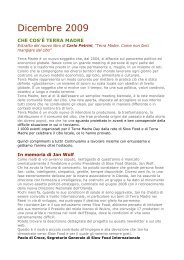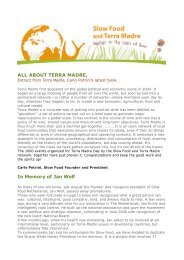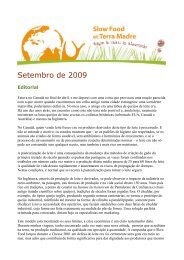all the food that's fit to print The Education Issue - Slow Food
all the food that's fit to print The Education Issue - Slow Food
all the food that's fit to print The Education Issue - Slow Food
You also want an ePaper? Increase the reach of your titles
YUMPU automatically turns print PDFs into web optimized ePapers that Google loves.
CO-Producer<br />
<strong>The</strong> Incredible, Edible, Unattainable Egg<br />
— By Gary Giberson<br />
How <strong>to</strong> get a loc<strong>all</strong>y sourced school lunch<br />
In 2004 my life as a chef and <strong>food</strong> service<br />
direc<strong>to</strong>r changed in unimaginable ways. At <strong>the</strong><br />
start of <strong>the</strong> twenty-first century in an industrial<br />
<strong>food</strong> world, procuring <strong>food</strong> for contract feeding<br />
is done with <strong>the</strong> click of a mouse. For a chef,<br />
operating a computer is akin <strong>to</strong> having classical<br />
knife skills. I had been through countless inservice<br />
computer training courses designed <strong>to</strong><br />
better prepare <strong>the</strong> user with <strong>the</strong> newest and most<br />
efficient web-based purchasing system. None of<br />
this, however, prepared me for what would be<br />
my greatest ch<strong>all</strong>enge: locating, obtaining, and<br />
purchasing eggs that were organic, local, and free<br />
range.<br />
That year, <strong>the</strong> Lawrenceville School, where I<br />
am <strong>the</strong> <strong>Food</strong> Service Direc<strong>to</strong>r, began what would<br />
prove <strong>to</strong> be a long and rewarding journey. We <strong>to</strong>ok<br />
<strong>The</strong> eggs that I was able <strong>to</strong><br />
purchase through <strong>the</strong> existing<br />
system were known in <strong>the</strong> <strong>food</strong><br />
service contract business as<br />
“liquid eggs”: picture boxed<br />
wine, and now imagine <strong>the</strong> box<br />
filled with ultra-pasteurized,<br />
homogenized, caged, medicated,<br />
enriched, whipped egg product<br />
on <strong>the</strong> daunting ch<strong>all</strong>enge of becoming a green<br />
and sustainable campus. My first ch<strong>all</strong>enge was<br />
<strong>to</strong> convince <strong>the</strong> <strong>food</strong> service contract company<br />
I was employed by <strong>to</strong> purchase from local and<br />
sustainable farms. This purchasing request was<br />
unheard of in <strong>the</strong> current school contract feeding<br />
environment. To understand this, however, I must<br />
first describe how <strong>food</strong> arrived at my kitchen.<br />
Menus and recipes were developed by corporate<br />
chefs <strong>the</strong>n approved by corporate dietitians<br />
who <strong>the</strong>n would submit <strong>the</strong> ingredient list for<br />
<strong>the</strong> menus <strong>to</strong> <strong>the</strong> corporate purchasing division,<br />
where <strong>the</strong> real decisions of purchasing are made.<br />
Once <strong>the</strong> items were identified and specifications<br />
determined, <strong>the</strong>y were put out for bid <strong>to</strong> <strong>the</strong> large<br />
industrial <strong>food</strong> manufacturers <strong>to</strong> determine price,<br />
availability, and most importantly, large-volume<br />
purchase incentives and rebates. When this<br />
process was completed and <strong>the</strong> <strong>food</strong> bids awarded<br />
<strong>to</strong> <strong>the</strong> manufacturers, <strong>the</strong> corporate-approved<br />
ingredients were <strong>the</strong>n s<strong>to</strong>cked by <strong>the</strong> approved<br />
national contracted <strong>food</strong> distribu<strong>to</strong>r. At my school,<br />
<strong>the</strong> approved menu items list was downloaded<br />
<strong>to</strong> my purchasing system, which restricted me<br />
in selecting only <strong>the</strong> items that appeared on <strong>the</strong><br />
approved list <strong>to</strong> be delivered by approved vendors.<br />
From my computer I would enter my purchasing<br />
needs and electronic<strong>all</strong>y send my order <strong>to</strong> a<br />
password-protected website two days before my<br />
scheduled delivery date. <strong>The</strong>se systems controlled<br />
my ability <strong>to</strong> know who was producing <strong>the</strong> <strong>food</strong><br />
and where it was coming from. This complexity<br />
can be rationalized when considering that<br />
because most school <strong>food</strong> budgets are limited,<br />
companies are forced <strong>to</strong> specialize in feeding<br />
students cheaply and efficiently while aiming for<br />
<strong>the</strong> greatest pro<strong>fit</strong>. But let’s get back <strong>to</strong> that egg.<br />
<strong>The</strong> eggs that I was able <strong>to</strong> purchase through<br />
this system were known in <strong>the</strong> <strong>food</strong> service<br />
contract business as “liquid eggs.” <strong>The</strong> product<br />
comes delivered in large, 20-pound plastic<br />
dispenser bags packaged in cardboard with a<br />
pouring spout. Envision boxed wine, and now<br />
imagine <strong>the</strong> box filled with ultra-pasteurized,<br />
homogenized, caged, medicated, enriched,<br />
whipped egg product with citric acid added <strong>to</strong><br />
preserve freshness.<br />
For me <strong>to</strong> procure organic, local, free-range<br />
eggs from <strong>the</strong> farmer adjacent <strong>to</strong> <strong>the</strong> school’s<br />
property was way out of <strong>the</strong> box. <strong>The</strong>se are just a<br />
few of many problems <strong>the</strong> <strong>food</strong> service company<br />
had with this request: <strong>the</strong> farmer was not on <strong>the</strong><br />
approved vendor list and did not carry a large<br />
general liability insurance policy; <strong>the</strong> eggs were<br />
still in <strong>the</strong>ir original packaging (a shell) and,<br />
<strong>the</strong>refore, could be hard <strong>to</strong> work with and possibly<br />
contaminated; <strong>the</strong> product was not pasteurized<br />
and potenti<strong>all</strong>y unsafe; and <strong>the</strong> corporate<br />
purchasing division could not negotiate a price or<br />
a large-volume purchase incentive rebate with <strong>the</strong><br />
local farmer.<br />
Continued on next page 17<br />
<strong>The</strong> snail | spring 2008







